Magnolia Lawn (Part 1)
Magnolia Lawn imagined
In my last post, I wrote about how the distinctive character of Peabody College developed over the hundred years since it was constructed at the current location. The most noticeable feature is the Esplanade, which evolved into its current form as buildings were constructed and small trees grew up along its sides in accordance with the plan created in 1912.

The other distinctive feature of the plan was a large greenspace located at the opposite end of the Esplanade from the monumental Social Religious Building (now the Wyatt Center). In the original plan, this space was to have a formal garden crossed by grassy paths. In the final plan, it was simply a grassy lawn mostly ringed by trees.
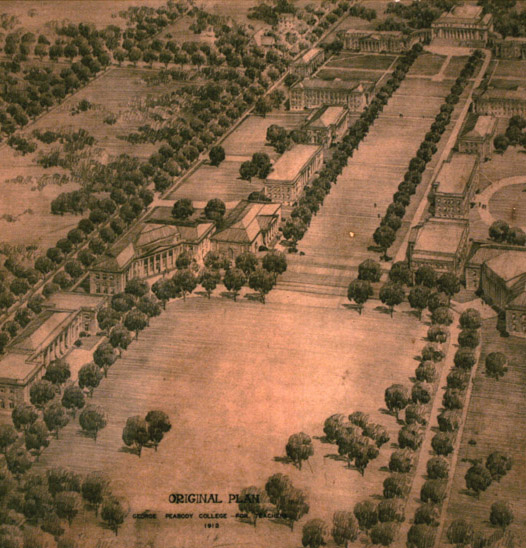
What did Magnolia Lawn look like at the beginning of Peabody College?
In reality, neither of these plans actually came to fruition. The greenspace, now known as Magnolia Lawn, was a largely wooded area for the first several decades after the beginning of the construction of the college. This can be seen in an aerial view from 1925.
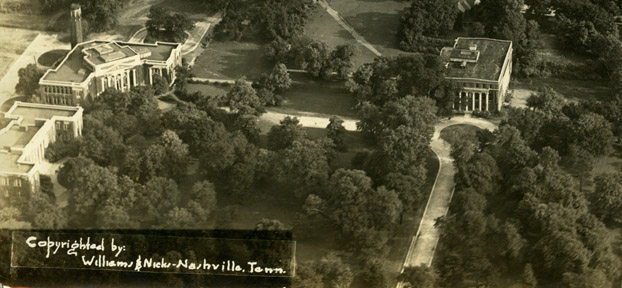
Although it is not possible to know how old those trees were in 1925, it is likely that at least the larger ones were there when the property was the site of Roger Williams university. However, it is also likely that at least some of the smaller trees were planted when Peabody College was established on the site. I have not yet found photos looking across Magnolia Lawn at the start of the college. However, there is a photo showing the east end of the lawn on the opening day of the college, July 24, 1914.

In this 1914 photo you can see that the smaller trees in front of the Home Economics and Mayborn buildings in the 1925 aerial photo are not present, so they must have been planted as part of the landscaping efforts around the new buildings. Because there are so many large trees in the early photos of Magnolia Lawn, it is difficult to track particular trees through time to determine which ones that are present in 2015 date back to 1925 and before. Most of the trees currently present in the Lawn are small enough that they were probably planted since then. However, there are several distinctive trees that we can track back to the start of the college.
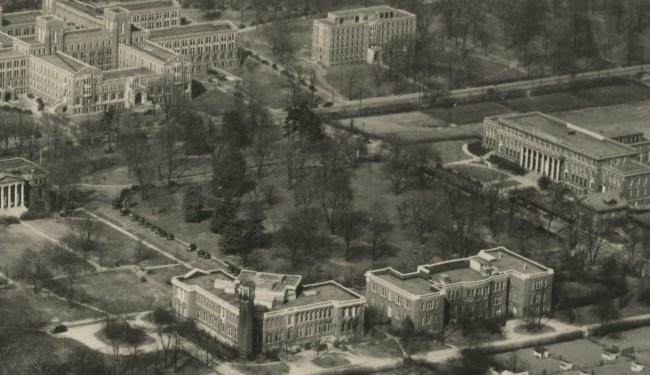
Phil Nagy of Vanderbilt’s Special Collections and University Archives recently found for me an exceptionally good aerial photo of Peabody and the Medical Center side of the main Vanderbilt Campus. The photo was taken sometime between 1928 (when North and Buttrick Halls were built) and 1932 (when Wesley Hall burned down). From my point of view, it was a great photo because it’s really easy to distinguish particular trees. I plan to make more use of it in future blog posts when I talk about some particular trees that I find interesting. But for now, I’ve included here the part of the photo showing Magnolia Lawn (above).
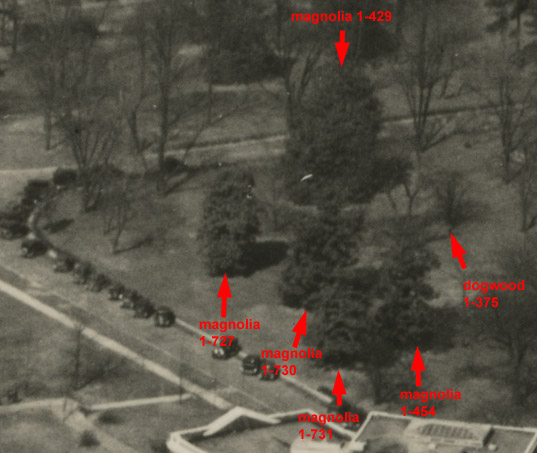
In this enlargement, I’ve labeled the distinctive trees on the southwest side of Magnolia Lawn that are still there today – I’ll talk about them next.
The Old Dogwood
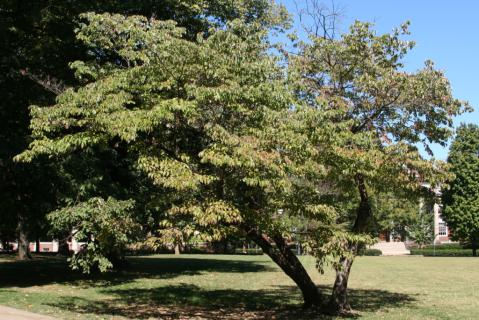
One of these distinctive trees is the dogwood 1-375 (Cornus florida), which is located just north of the sidewalk that crosses the lawn diagonally. This dogwood is easy to distinguish for two reasons. One is that it has been located in a relatively open part of the lawn for most of its history, making it easy to spot in photos. The other is that the tree has a distinctive split trunk with each trunk originally forking again.
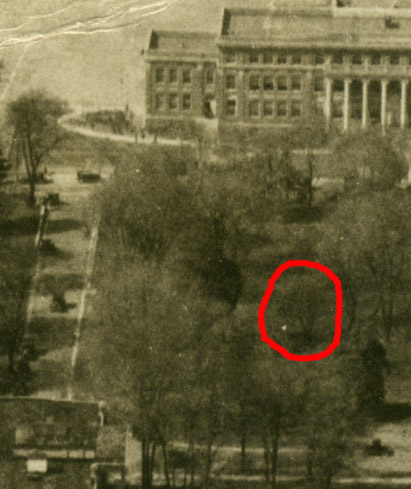
You can just make out those trunk features in the enlargement of the 1925 photo that was featured in the last blog post.
Here’s a closer view of the tree in 1974 – the distinctive dogwood bark and split trunk is a give-a-way that it’s the same tree. (Click here to see the image at larger resolution.)
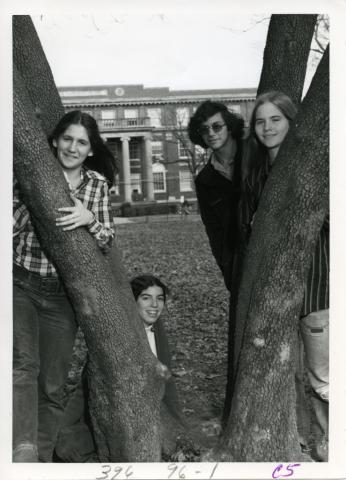
The more distant trunk on the right is no longer there and the two trunks on the left are leaning much more precariously than they did 40 years ago. (Click here to see a photo from the same spot in 2015.) However, the tree is alive and well at a ripe old age of at least 100 years, if we assume that it was at least ten years old in the 1925 aerial photo. That makes it probably the oldest dogwood tree in the arboretum.
Magnolias
One of the most striking features of Magnolia Lawn in 2015 are the large southern magnolias (Magnolia grandiflora) that give their name to both the lawn, and to Magnolia Circle, the road that surrounds it. There are five magnolias that are very large and very old. Two of them are among the 30 largest trees on campus: 1-730, which is the center magnolia of the cluster on the south side of the lawn, and 1-429, which is on the west side of the lawn across from the Kennedy Center.

It is apparent from this 1925 photo that these five magnolias do not dominate the lawn in the same way they do today. One reason is that in 1925 there were many trees that were as large or larger than those magnolias. Today, that is not the case, particularly on the west side of the lawn.
Over time, the west side of Magnolia Lawn has gotten progressively more open. I’m not sure if that was by design, but I suspect that at least unconsciously there may have been an effort to create a more open viewshed along the main axis of the Esplanade. Once the Demonstration School (now University School of Nashville; USN) was built in 1925, there was a clear visual axis between it and the Social Religious Building (now Wyatt Center), and there may have been a desire to keep these two dominant buildings visible all along the axis by not replacing large trees that came down on the western half of the lawn. (See the last photo on the page which was taken at a time when the lawn was probably as open as it has ever been.) More recently, that part of the lawn has been used for graduation ceremonies for both Peabody and USN, and it must be kept open enough to fit the large tent under which the ceremonies are held.
The other factor is that the magnolias are now a lot larger than they were in 1925. The largest of them, the center magnolia on the south side of the lawn (1-730), is about 22.5 meters (about 75 feet) tall in 2015. It has a trunk diameter of 123 cm (48 inches) and crown spread of 15 meters (about 50 ft). There are a few magnolias in the arboretum that are larger than this (including one in front of Buttrick Hall and another in front of Kirkland), but it’s still massive. Although the other four big magnolias on the Lawn aren’t as large, they still top out at 16 to 20 meters (55-65 feet). So just how big was magnolia 1-730 in 1925?
Nerdy analysis of the size of magnolia 1-730 in 1925-30
As a biologist, I love collecting and analyzing data. If you are bored with technical details of this section, you can skip over the calculations and just look at the pictures and the last paragraph.
Because 1-730 is in the open and clearly recognizable in many photos, it’s relatively easy to compare it with other objects of known height. The first image that I analyzed was from the archives of the University School of Nashville. It is a picture taken from the front door of the Demonstration School a few years after it was built.
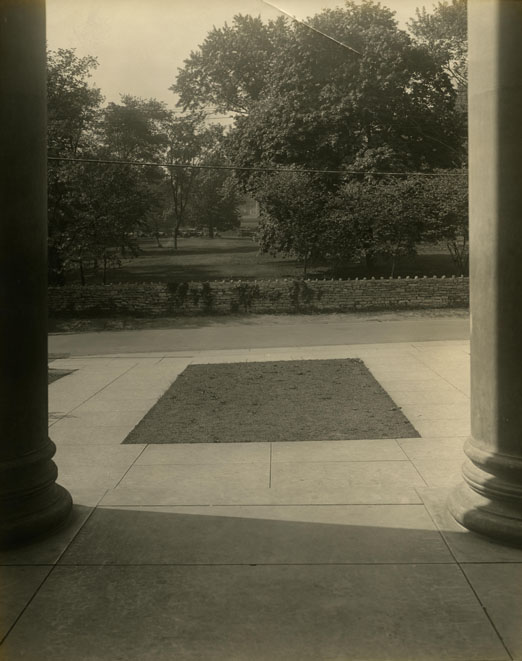
Of course, the first thing I had to do after seeing this image was to walk over to the front door of USN to see what it looked like now:
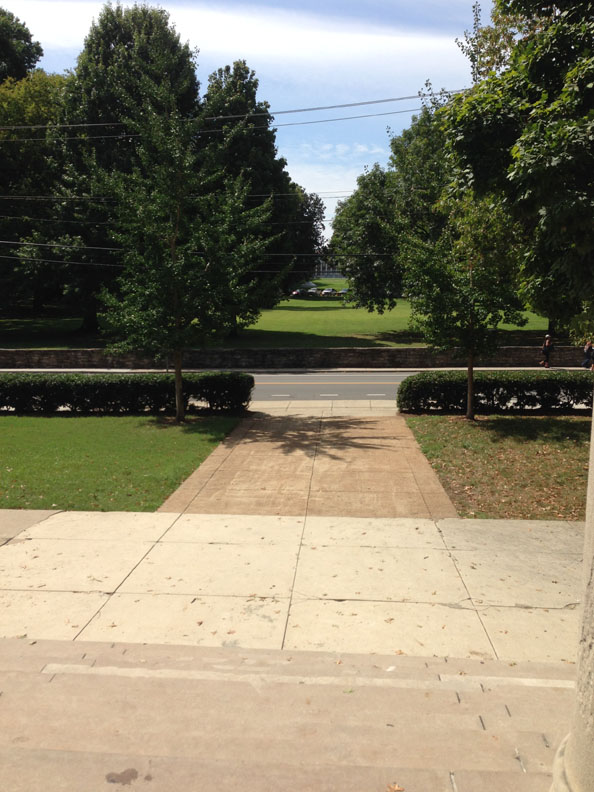
There are some changes in the sidewalks, hedges, and the stone wall across the street, but the view 85 years later is surprisingly similar. Here’s a comparison of an enlarged view showing the Social Religious Building/Wyatt Center in the distance:
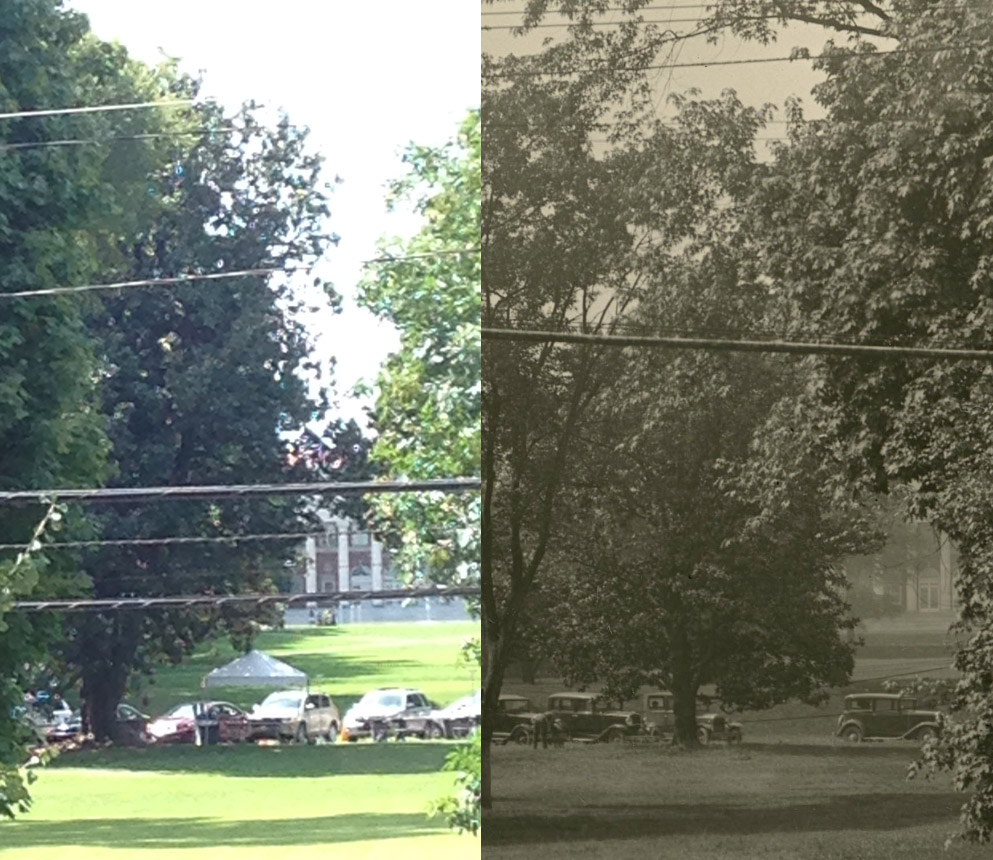
One striking difference is in the cars parked along Magnolia Circle. That’s one thing that has definitely changed! However, the columns, doors, and windows of the Wyatt Center have changed very little.
I took care to enlarge these images so that the dimensions of the features of the Wyatt Center were identical in the two images. Since I took the image from the exact same spot as the 1930 image, I can compare the dimensions of magnolia 1-730, which is clearly visible at the left in both pictures. Using the present-day dimensions for height, diameter, and crown spread, I came up with a scale of about 30 pixels per meter at the distance of the tree. Applying this scale to the 1930 photo, I estimate that its height was about 17 meters, crown spread about 10.6 m, and trunk diameter about 75 cm.
The second analysis that I did was to estimate the height from the first aerial photo on this page (the one from 1925). To determine the scale on this photo, I went over to the Iris Cafe at the Peabody Library with a meter stick and tape measure to do a little geometry and determine the height of that side of the building. The height of the columns on that side of the building are about 8 meters, and the building itself is approximately 10 meters tall. Using that information to scale the image, I estimated the heights of the visible magnolias as: 9.5 m for 1-730, 9.5 m for 1-454, and 9 m for 1-727. Using the image from 1925, I estimated the crown spread of 1-730 to be about 9.6 m.
The third analysis that I did was to estimate the height using the nice 1930 aerial photo (PC.CAS.AERP.013). Assuming a height of 10 meters for the Peabody Library, I estimated the heights of the magnolias as: 10.5 m for 1-730, 10.4 m for 1-454, 9.3 m for 1-727, and 8.9 m for 1-731.
Obviously there is considerable uncertainty in these estimates. The last two sets of estimates both depend on my estimate of the height of the library, which was established in a very crude manner. Trees also don’t have very definite edges, so it’s somewhat of a guess to tell exactly what is the top and bottom of a tree in a photograph. In any case, we can conclude that the height of magnolia 1-730 was probably between 9.5 and 17 meters tall in 1925-30, vs. it’s height today of 22.5 m. Its trunk diameter was about 75 cm then and 123 cm now, while its crown spread was about 10 meters then and 15 meters now. By any of these measures, 1-730 is much larger now than it was in 1925-30.
The name “Magnolia Lawn”
Common parlance and every current map refer to this greenspace as “Magnolia Lawn”, while the drive that surrounds it is called “Magnolia Circle”. One thing that I wanted to try to determine for this post was the date when people started using the adjective “Magnolia” to refer to these two things. I did some minimal research of historical accounts of Peabody and went over to the archives to try to find old maps of Peabody, but to no avail. I’m sure that there is probably some information about this somewhere, but I haven’t found it yet. If any readers have information on this subject, please let me know.
I’m guessing that the space wasn’t called Magnolia Lawn at the beginning of Peabody College for the reasons I’ve noted above: the magnolias weren’t that big, and there were a lot of other trees that were bigger than them in 1925. But beyond that, there is little I can say about the name. (Note added later: see this blog post for more on the name of the lawn)
How old are the magnolias of Magnolia Lawn?
The obvious question, and the question that got me started on the nerdy analysis of the size of the magnolias in 1925, is “how old are the big magnolias of Magnolia Lawn?” It seems apparent to me that the magnolias predate Peabody College at this site. The college relocated here in 1914 (see the previous blog post for more on that), and in order for the magnolias to be the size I estimated above, they would need to be more than 10 or 15 years old. However, being the data nerd that I am, I wanted to collect more data to more precisely answer the question of their age.
There are several historical aerial photos that show 1-730 clearly and I was able to georectify them using GIS software. This enabled me to use the software’s measuring tool to estimate the crown spread fairly accurately. I graphed the crown spread vs. year and computed the regression line through the data:
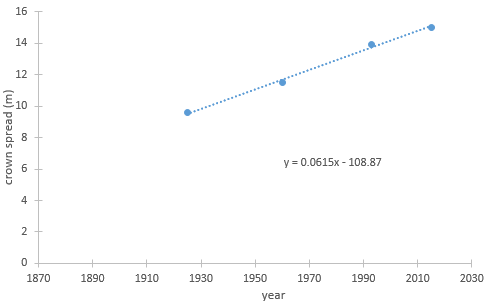
The data were surprisingly consistent within the 90 year period over which I had data. One would be tempted to use the equation of the regression line to extrapolate back to the time when the crown spread was zero (i.e. when the tree sprouted). Doing so produces a date of 1770. This is completely silly since it extrapolates far beyond the data and it is unlikely that the magnolias were around before the Battle of Nashville in 1864, when most of the area was almost entirely denuded of trees. However, it’s probably safe to extrapolate to 1914 and conclude that 1-730 was here when Peabody moved to this site.
What would be really interesting would be to know the typical age for southern magnolia trees that are about the size that 1-730 was in 1925-30. Fortunately, we have historical data for other trees growing under similar circumstances elsewhere on Vanderbilt’s campus. The history of the screen of magnolias planted around the perimeter of Vanderbilt’s main campus is well documented in the history of the arboretum. It is known that the southern magnolia trees planted in front of the Law School were small when it was constructed in 1962. (See the photos of the original gates of Vanderbilt in 1917 and 2014 to put the location in context.) According to the story, Margaret Branscomb had been the motivating force for planting those magnolia trees, and when the Law School was under construction, she had them dug up and moved to the chancellor’s residence (at the current location of the Zerfoss Student Health Clinic) for safekeeping until the construction was done.
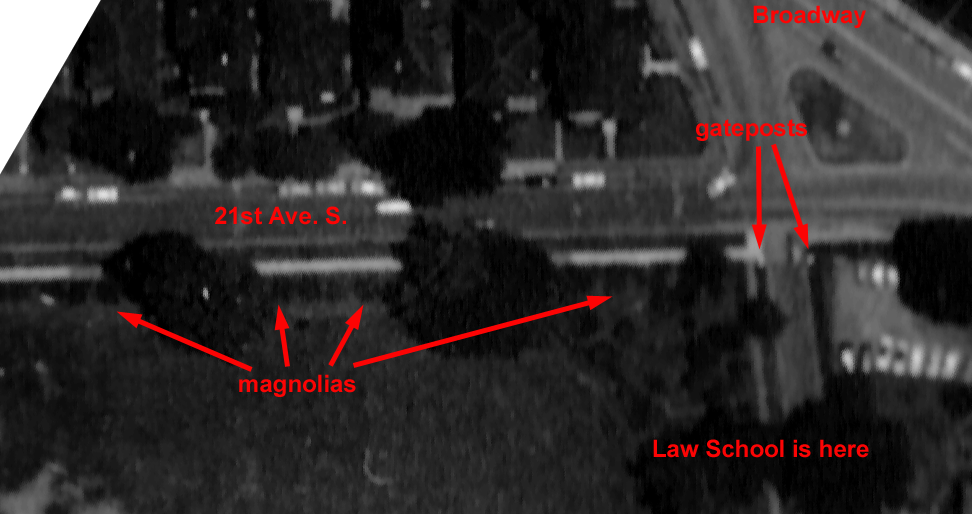
In the photo above from between 1957 and 1959, we can see the row of small magnolias along 21st Ave. S. Using the GIS measuring tool, I can determine that at that time they had crown spreads of about 3 meters. This seems a bit large for digging up and moving, so it may be that those spoken of in the story were further to the south of the ones marked in this photo. In any case, we can establish that the row of magnolias in front of the Law School are at least 55 years old (since they appear in this aerial photo) and possibly may be five to ten years older than that (if they really have crown spreads of 3 meters).
Of course, the logical next step is to measure those same trees now to see how big they are at the present time (in 2015). I measured the diameter of 9 haphazardly selected magnolia trees along 21st Ave.S. in front of the Law School, estimated the height of 5 trees, and the crown spread of 6. Here’s what I found. The average height was 13.2 m (range: 10 to 15 m, standard deviation 1.9 m). The average diameter was 43 cm (range: 33 to 62 cm, s.d. 9.1 cm). The average crown spread was 11.3 m (range: 10.5 to 11.8 m, s.d. 0.57 m).
We can see that these trees in front of the Law School are now approximately the same size that magnolia 1-730 was in 1925-30. Since the Law School magnolias are at least 55 years old, if we assume that 1-730 was a similar age in 1930, it would have sprouted in 1875 or possibly before, making 1-730 approximately 140 years old. I’ve tried to be conservative in these estimates, which would make this a lower limit on its age. On the other hand, the other four big magnolia trees in Magnolia Lawn are smaller than 1-730, and I might have biased the estimate by picking the largest tree (if they were all planted at the same time). Taking all of this into consideration, I would say that an estimate for the age of the large magnolias on Magnolia Lawn of 140 years is probably reasonable.
We know from the history of the trees on the main Vanderbilt campus that the oldest (and largest) magnolias there would have been planted around the time of the construction of the university in 1875. Since magnolia 1-730 is a similar size to those trees on the main campus, a planting date of around 1875 would be reasonable. We know that the site of the current Peabody campus was purchased by 1874 by Rev. Daniel W. Phillips as the site for Roger Williams University (see the previous blog post for more on Roger Williams University). So it is possible that around the same time that Bishop Holland McTyeire was engaged in his massive tree-planting campaign on the main Vanderbilt campus, Rev. Phillips and his students may have been engaged in a parallel effort on the Roger Williams University. In any case, we can be thankful for the vision of the tree-planters of 140 years ago that has allowed us to enjoy the beauty of the massive southern magnolias that grace Magnolia Lawn today. [Note added later: Magnolia Lawn apparently was not part of the Roger Williams campus, but rather part of Charles A. R. Thompson’s estate and location of his Victorian home “Edgehill”. See this blog post for more details.)
Other noteworthy trees of Magnolia Lawn
Unfortunately, few if any of the other trees present on Magnolia Lawn at the establishment of Peabody College have survived.
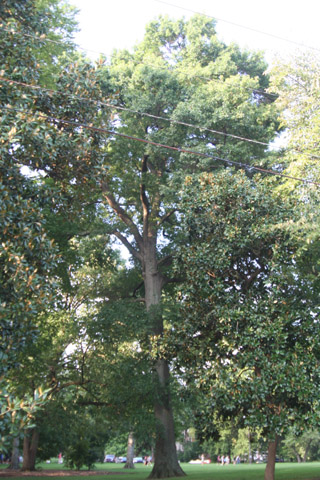
The largest non-magnolia on the lawn is a pin oak (Quercus palustris) in the northwestern part of the lawn. Pin oak 1-625 is the largest member of its species in the arboretum. Unfortunately, because the trees in that part of the lawn are more crowded, I haven’t been able to track it back through time in the historical aerial photos to determine its age. However, based on its diameter of 115 cm and comparison with oaks elsewhere on campus whose age I know, I would estimate it to be 90-100 years old.
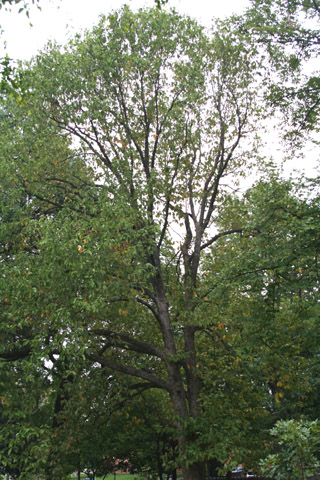
I would be remiss if I failed to mention an unconventional magnolia that can be seen in Magnolia Lawn. One of the larger trees in the east side of the Lawn is an individual of Magnolia acuminata, also known as “cucumber tree”. Although this is a species of magnolia, unlike southern magnolia it does not have evergreen leaves, so most people would not recognize it as a magnolia.
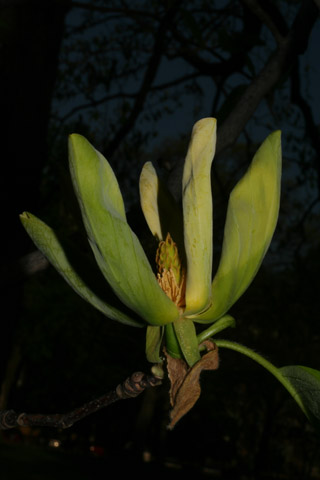
Although morphologically similar, its flowers are superficially quite different from those of southern magnolia: green and not at all showy. The name “cucumber-tree” comes from its green, immature fruits that might remind one of the vegetable.
In the shade of the big cucumber-tree, there are three small hickory trees that were planted in 2005 to enlarge the scope of the arboretum: a shagbark hickory, a kingnut hickory, and a pignut hickory. Although these trees are still small, this is the only place on Vanderbilt campus where you are going to see them. These species are relatively common in the forests around Nashville and have distinctive bark and nuts when full grown. Come back in 50 years to see what they look like as adults!
Next time…
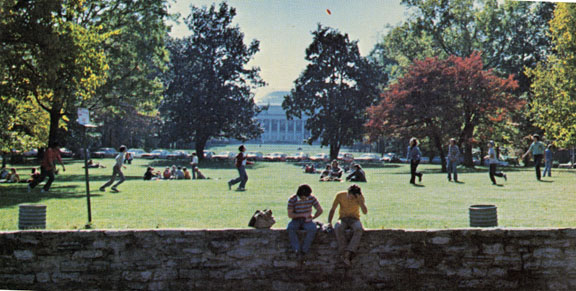
I wanted to include in this blog post some information about the special relationship between Magnolia Lawn and the Peabody Demonstration School (University School of Nashville), but this post is long enough. So I’ll include it in a separate post to follow.
Acknowledgements
Many thanks to University School of Nashville archivist Jenny Winston, Huey Brantley of Vanderbilt Facilities Information Services, Vanderbilt GIS coordinator Lindsey Fox, and Philip Nagy Vanderbilt of Special Collections for their help in locating the material I used to create this post.

Steve Baskauf is a senior lecturer in the Biological Sciences Department at Vanderbilt University. He serves as the communications coordinator for the Vanderbilt Arboretum and can be contacted at steve.baskauf@vanderbilt.edu. Posted 2015 October 25.